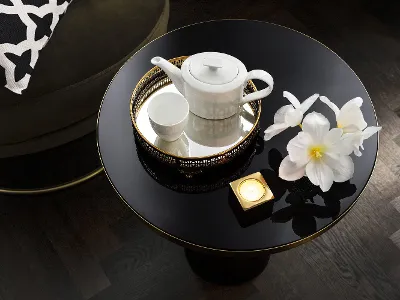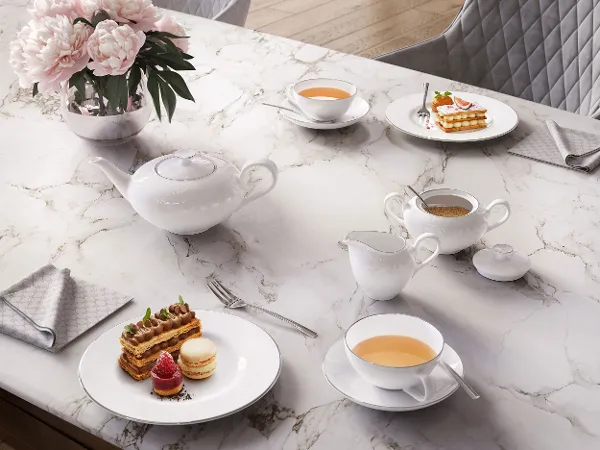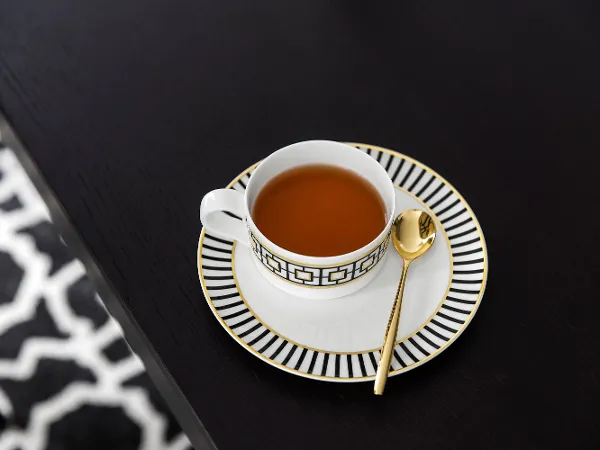
Tea with milk
Opinions often differ greatly when it comes to tea with milk. Many seasoned drinkers swear that the best way to drink tea is pure, without adding milk. Others - and by no means just the English - consider that a little milk improves the tea, especially black tea, even if it likely prevents the potential health benefits of some of its active ingredients.
We think everyone should drink tea just the way they like it. With milk, with cream, with sugar or sweetener, with a dash of lemon juice or just plain. Nevertheless, or perhaps precisely for this reason, we take a look in this article at the controversial topic of tea with milk, discuss its history and taste, and provide some tips on which teas are good and which are not.

Why tea with milk?
There are many possible answers to this question: not to damage the porcelain, or to use fewer tea leaves, which can be expensive. However, it is much more likely that tea (it is similar with coffee) is enjoyed by many with milk, simply because it tastes good.
And why do many English people drink tea their with milk? Probably for the same reasons, but the British are even more particular in their tastes. There are two camps: Milk-in-first (Mif) and tea-in-first (Tif). We're not sure whether that actually makes a difference, but in the UK this sequence is often passionately debated.
How healthy is black tea with milk?
Cardiologists at Berliner Charité hospital found that adding milk to black tea cancels out its health benefits. The tea owes these to the tannic acids it contains, which provide the slightly bitter taste, but are also antioxidants which help to prevent arteriosclerosis by dilating the arteries. Apparently the milk protein, casein, combines with the tannic acids to prevent this occuring. However, there are other studies which suggest that the effect of milk in tea is only that the tannins are absorbed more slowly, i.e. that it takes longer for the human body to metabolize them. So if you drink black tea primarily, or exclusively, for its positive effects on your health, you should consider whether to avoid adding milk or cream, and instead drink your tea black. However, if tea is primarily a matter of enjoyment and taste for you, you should not let this stop you from rounding off the taste of your tea with milk or cream as you wish.
Tips for preparation
Whether you first add milk to the cup and then the tea, or vice versa, is of course up to your personal taste. The British Standards Institution (BSI) recommends first letting the tea steep for 3 to 5 minutes, and then pouring it directly into the cup or a teapot.
The East Frisian tea convention, on the other hand, recommends that white sugar be placed in the cup first, then the hot tea poured in, and finally a dollop of cream added in a circular motion. Frisians frown on stirring.
We recommend using fresh milk with 1.5 to 3.5 percent fat content, and warming this to room temperature before adding it to the tea. A small milk jug that holds enough milk for a whole teapot is ideal for this. Frist, warm the teapot by rinsing it with hot water. Add the tea leaves, and leave to infuse for 2 to 5 minutes, depending on taste and variety. Then pour the tea into a clean glass or porcelain teacup once ready, using a tea infuser or strainer to remove the tea leaves from the tea. Remember, the longer the tea steeps, the more intense the aroma and the more tannins are released.
Which varieties of tea can be mixed with milk?
Generally all black, non-aromatic varieties of tea can be drunk with milk to enhance the flavor. You can also serve green tea with milk, such as chai latte enriched with other spices and flavors.
You should be careful with flavored tea, and fruit teas. It is best to look at the packaging to see whether the manufacturer recommends drinking their tea with milk. This is because many types of tea can taste different in combination with milk or even - as with fruit teas - cause the milk to congeal due to the acids it contains. Earl Grey black tea, flavored with bergamot, is often enjoyed in the UK, preferably without milk.
Suitable varieties of tea to drink with milk
- Assam
• Ceylon
• Chai
• Earl Grey
• Rooibos and honeybush
Does tea taste good with milk?
It’s true that adding milk to tea changes the taste. Strong black tea in particular loses its bite with a little milk, making it taste more rounded and milder. However, in no way do we want to convey that drinking tea without milk does not taste good or as good, because, for example, black tea is traditionally enjoyed strong in the Arabic world with plenty of sugar and without milk - and they have been doing it that way for thousands of years.
So our recommendation is this: try your favorite tea both ways. Test it out and see how it tastes without milk, and how the taste changes when you add a little milk to the cup. This way you can determine your own preferences, and in the future perhaps you will only drink certain varieties of tea with milk, while preferring other varieties without.

When did people start drinking tea in England?
The traditional time for tea is usually between 4 pm and 5 pm in the United Kingdom, but it is referred to there as “afternoon tea” or “low tea”, since it was traditionally enjoyed in the parlor at a low table. But for a true Brit, “tea time” is any time!







